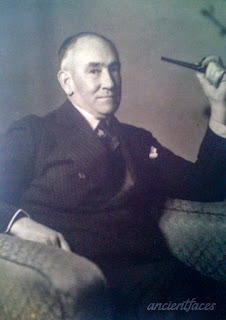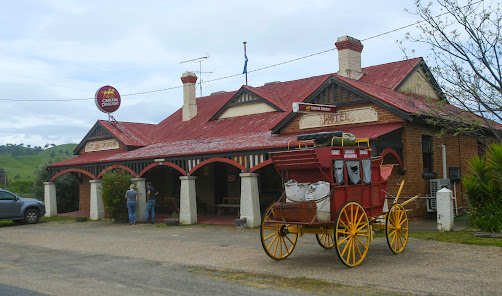Peter Grant Hay: How one bloke went from being a Tasmanian Hop farmer selling illicit booze to Chicago Mobsters to being a Victorian brewer supplying beer to the US Army.
Happy to confess that until December last year I’d never heard of Peter Grant Hay, or knew anything about his brewery or his notoriety but then on a glorious summer afternoon I was paddling my kayak in Jervis Bay, NSW and pulled onto a rarely-visited beach for a break.
The top end of a beer bottle was reaching up from the sand and figuring it would be broken and with sharp edges, I grabbed it to take home and chuck out. Only it wasn’t broken, just full of sand and ocean debris. It had a lion’s head on its shoulder and ‘Richmond N.S. Brewery’ at its base.
There was no message IN the bottle, but I brought it home, hit it with the gerni and then hit my books and the net to find out just exactly what was the message OF the bottle.
In mid-1927 Peter Grant Hay had a cash-flow problem.
At farms in Tasmania’s Derwent Valley and at Bright, Victoria, his family company produced the finest hops in the country and were the major suppliers to the Carlton United Brewery.
Early in ’27 Carlton sought to exploit their market dominance by slashing their offering price for hops. Grant Hay, refused, managed to sell the current crop to Sydney’s Tooheys Brewery and decided to not take the corporate bullying lying down.
He called his managers to a meeting in Melbourne and they decided to get to work on their own damn brewery.
Hay knew he needed funds. He also knew the liquor trade, he knew business, and he knew that the place on the planet paying the highest amounts for booze were the wise guys of prohibition-shackled Chicago.
Back before WW1, Hay had met Arnold Resch on the ship when he sailed to America – this would’ve facilitated offloading his hops when he called Carlton’s bluff in ’27. The pair visited the great breweries of Milwaukee but Hay must’ve made a few other contacts in the US.
Faced with his need for cash, Grant Hay ordered a bulk shipment of purified gin from the HQ of the occupying British Army in Lahore, Pakistan Once it arrived, in Melbourne, he had it rebottled and shipped to mobsters in Chicago.
This single deal of selling booze to bootleggers, netted Grant Hay a million pounds – that’s $2,000.000 and that’s almost a century ago.
It set him up for life and it wasn’t the last time that the Americans were to prove a windfall for Peter Grant Hay.
On his way home from America in 1914, Hay had visited Dr Leopold Nathan who’d invented a pasteurization-based new brewing system and now in 1927 he cabled Nathan and ordered a complete Nathan Brewing System along with the services of a master brewery to set the thing up. Simultaneously he bought five adjoining industrial sites on Church Street in Richmond. A decent slice of his bootlegging proceeds was being put to good use.
In August he received permission to demolish the existing buildings and construct his brewery and when the excavation contractor got narky about the rock he was busing, Hay gave him the flick, got himself 3 tonnes of gelly and blew his own holes in the ground.
The new brewery was ready to go in Easter 1928 and on April 28th the Lager and Bitter began to flow. Within three years over 300,000 bottles were rolling out each week.
Each bottle featured a raised Tiger’s head on its shoulder, just like the one I’d found in the sand of Jervis Bay. It’d been designed by Hay’s wife, recognition no doubt to the local Richmond Football Club which had been formed in the Royal Hotel at Richmond in 1885.
(As my intrigue grew, I managed to buy a few Richmond bottles at auction and found there were different shapes, some with stepped shoulders and some smoother. And there were two tiger designs, one front on and one in profile. I’ve not been able to establish the reasons or significance.)
Anyway, originally known as the ‘Richmondites’ or ‘Wasps’ the Richmond Football Club very soon, became the Tigers and Hay was a keen sponsor and supporter, in 1931 offering them a whopping £25 if they won the premiership. They didn’t collect but made amends the following season.
Hay’s relationship with his imported head brewer, Heinrich Walter Haenggi began as a close and trustful collaboration but by 1929 the relationship between them had fermented into a less palatable brew with Hay accusing the Swiss of receiving secret commissions from publicans to stock Richmond beers.
On the 2nd of December 1929, Haenggi was punted by Hay and reacted by suing for breach of contract.
Hay’s defence of the charge was that Haenggi had been acting as an agent for opposition companies in both Sydney and Perth to purchase rights to the Nathan System and that this contravened a clause in his contract to work only in the interests of Richmond Brewery.
After a five-day trial, the Chief Justice of Victoria, Sir William Irvine, delivered the bad news for Grant Hay announcing that he could, “rely little on the accuracy of his evidence.”
He went to characterise Hay as, "excitable and even reckless in the witness box, making statements ...broadly contradictory of one another, without giving himself time to think of what he was saying."
Ouch!
But then the judge, broke down his judgemental shottie, reloaded and took aim at the plaintiff: “I can place even less reliance on the evidence of Haenggi, who admitted, with callous indifference, that he was not unwilling to deceive those with whom he had dealings out of Court, and whose demeanor in the box failed to convince me that he had left that habit behind when he came into Court.”
Ooh!
Bullshit, like beer, comes in a range of strengths and His Honor concluded that he was, “disposed to accept the evidence of Hay against that of the plaintiff, where there is a conflict” and dismissed Haenngi’s claim, with costs.
Aah!
Grant Hay moved into the 1930’s with his foot to the floor and the taps wide open. Richmond tripled their output and then increased it again but struggled to satisfy the market’s thirst. Away from brewing Hay – a keen fan of horse-flesh he his horses won both the Irish Guineas and the Caulfield Cup, plus he splashed out and bought the Sandown Racecourse.
Faced again with Carlton’s monopolistic muscle, Hay now began to buy his own string of pubs and by 1936 he claimed to have ‘about 50 hotels under (Richmond) control in Victoria.
This was the year when the Richmond Brewery began a price war in Victoria.
Unable to break Carlton’s monopoly of selling through licensed grocers Grant Hay reduced the price of bottled beer to
9½d compared to Carlton’s 12d claiming it was in reaction to CUB’s tactic of employing men who ‘will walk into a crowded bar where Richmond is sold and call for beer. They take a sip and ask the barman what brand it is. When he replies 'Richmond,' they spit it out with a string of oaths and say: "That filthy stuff's not worth drinking. Why don't you stock. . . ?' Speaking, no doubt from personal experience and, I’m guessing with no trace of irony, the man who’d got his start in business by selling booze to Chicago mobsters complained to Smiths Weekly that these were, “American gangster tactics.”
9½d compared to Carlton’s 12d claiming it was in reaction to CUB’s tactic of employing men who ‘will walk into a crowded bar where Richmond is sold and call for beer. They take a sip and ask the barman what brand it is. When he replies 'Richmond,' they spit it out with a string of oaths and say: "That filthy stuff's not worth drinking. Why don't you stock. . . ?' Speaking, no doubt from personal experience and, I’m guessing with no trace of irony, the man who’d got his start in business by selling booze to Chicago mobsters complained to Smiths Weekly that these were, “American gangster tactics.”
Originally Hay’s purchase of Sandown Racecourse was a recreational whim, but three years into WW2 and with Darwin being bombed, his ownership of this real estate turned out to be a business masterstroke.
The fall of Singapore caused an American tactical rethink, now deciding that Darwin was to be line in the sand, General Douglas MacArthur relocated his HQ from Manila to Melbourne in March 1942.
When he arrived in the southern capital, just a couple of paces behind were two mates of the US President, brothers, Bruce and Sheridan Fahnestock, who’d undertaken two famed South Seas exploring expeditions in 1934 and in 1940.
MacArthur had been tasked with the creation of a citizens’ flotilla of small ships which would become a supply chain for the Allied forces in northern Australia and New Guinea, and it was the job of the Fahnestock brothers to bring this to fruition. Fast.
Sandown Racecourse had been turned into a camp for American servicemen and the Fahnestocks, members of their exploring group, and other officers inspected the US troops stationed there.
Never one to miss an opportunity, Grant Hay used the visit to forge an agreement with the US Army officials to supply Richmond beer to US and Allied troops in Egypt and in North Africa.
He also chucked his 72 ft ketch, the Jane Moorhead, which he’d been using to bring hops over from his Kentdale property in Tasmania, into the citizens’ flotilla, codenamed ‘Mission X’ but unofficially known as the ‘ragtag fleet’.
A total of 3327 men were recruited to crew this motley armada. Ships from other centres were first sent to Sydney where each was fitted with a single machine gun and an American Flag and then loaded with metal matting for airstrips; high-octane gasoline; trucks, jeeps and bulldozers; spare parts; guns and ammunition; mail; boots and helmets; medical supplies, dehydrated, canned and powdered food, oh, and, of course Richmond beer.
Nine years earlier, FDR had signed an amendment to water down the Volstead Act 0f 1919 which had prohibited the manufacture, transportation and sale of beverages with more than 0.5 percent alcohol.
Peter Grant Hay had come full circle: from supplying spirits to the prohibition mobsters and bootleggers, he was now quenching the thirsts of the servants of the United States President who had put an end to these same criminal networks.
Post war, the Richmond Brewery continued to eat away at CUB’s market share and by 1960 they had 16% of Victorian beer sales and 8% nationally. (Keith Deutscher in his beautiful and authoritative volume, “The Breweries of Australia: a history” claims market share was 6% in Victoria.)
Peter Grant Hay died in August 1961 and with no succession plan in place, his widow played off the business between CUB, Asahi and Courage. Finally she settled for the old nemesis, Carlton who sealed the deal on Australia Day, 1962.
It was a classic ‘catch and kill’ operation. Less than three months after buying it, CUB shut down the Richmond Brewery. The magnanimous company compensated the laid-off workers with an open bar at the Prince Alfred Hotel across the road.
For, wait for it, all of 30 minutes.
Soon the buildings were demolished and the rich amber legacy of Peter Grant Hill’s – very likely the only Australian to ever work for both Al Capone and General Douglas MacArthur, was at an end.
As is my message from my prized bottle with its Tiger’s head.











Wow enterprising fellow. Great read
ReplyDelete